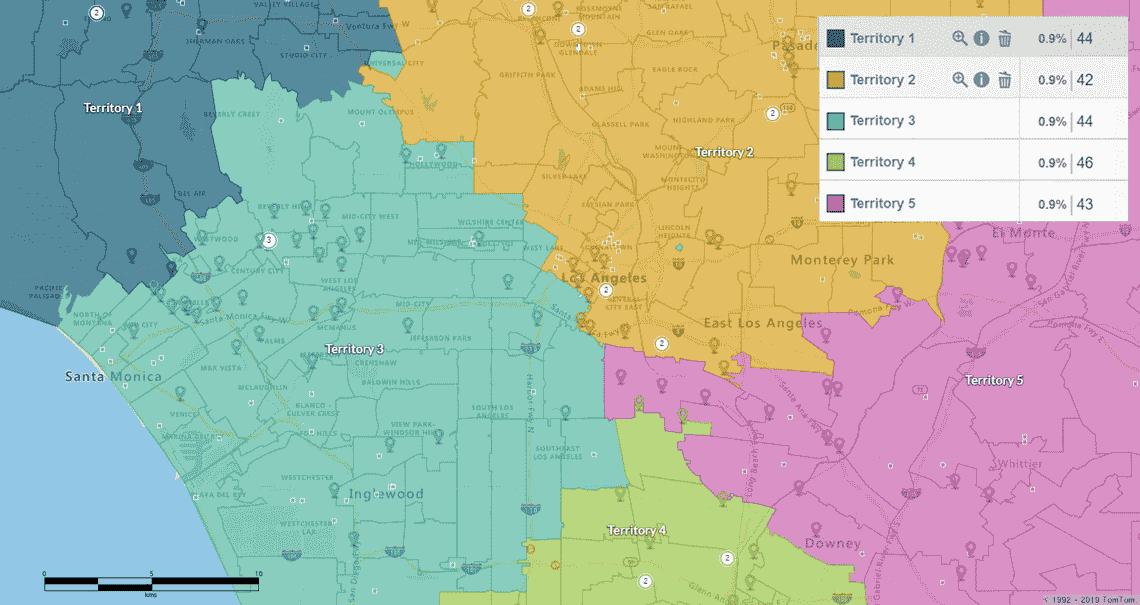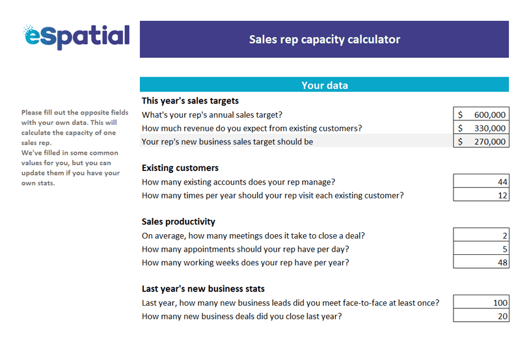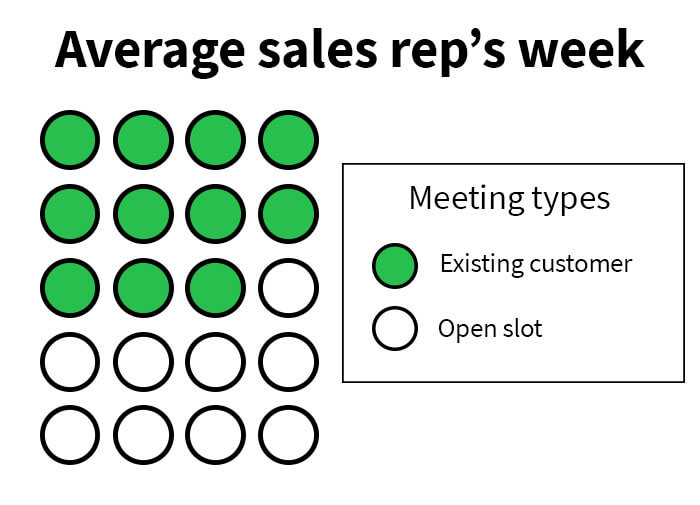Quick answer
Key Takeaways
- Not all reps are operating at full potential; visibility reveals where effort and results misalign
- Territory design directly affects rep workload, customer coverage, and revenue opportunity
- Without clear timeframes and targets, it's easy to over- or under-hire
- Capacity isn't just about volume; it's about focus, fit, and flexibility
Strategic sales capacity planning is about unlocking hidden potential and driving performance where it counts. Find out how eSpatial's mapping and modeling tools can give you the clarity to identify sales capacity gaps, forecast rep productivity, and make confident decisions.
What is Sales Capacity Planning?
Sales capacity planning is the process of determining whether your sales team has the right number of reps with the right skills in the right places to meet revenue goals.
It involves analyzing data like workload, territory potential, and travel time to balance resources and avoid over- or under-servicing accounts. eSpatial's flexible mapping software allows you to visualize this data geographically, which is a game-changer when planning your sales capacity.
Why Sales Capacity Planning Matters
Getting stuck in a rut is bad for business, especially when it comes to your sales team. Just because you've had five sales reps in a region for years doesn't mean it's the ideal number. That's why you need a sales capacity model.

If you haven't reviewed your sales territories recently, business activity may have drastically changed. And if your sales reps have too many accounts or leads to follow up with, you're probably missing out on sales. On the other hand, if things have slowed down, you may be able to save on expenses by reducing staffing levels.

Download your free Sales Rep Capacity Calculator
Download NowHow to Build a Sales Capacity Plan
Assess your sales capacity by analyzing key inputs like targets, timeframes, and rep productivity. Then model, forecast, and refine through regular reviews and adjustments. Armed with this data, you'll have a better idea of how to create a sales strategy that makes the best use of your salespeople.
Step 1
Gather Key Sales Inputs
Start by collecting the data that drives sales performance. This includes:
- Sales targets and revenue goals
- Historical sales data
- Customer and account data
- Rep workload metrics
- Average deal size
- Territory and geographic data
- Sales cycle and conversion rates
- Rep capacity and headcount
- Market potential or opportunity data
This data will create a baseline that will shape the accuracy of your entire capacity plan.
Step 2
Set Revenue Targets and Timeframes
Define clear goals for revenue and time, whether quarterly, annually, or project-based. Break these targets down by territory or region using business data mapping software. This will allow you to tie sales goals to geographic potential and spot where expectations may be unrealistic or under-ambitious.
Step 3
Model Rep Productivity and Output
Estimate what your reps can deliver based on past performance, market demand, and territory complexity. Consider factors like average closing rates and the number of selling days available to calculate realistic output expectations. Route planning software for sales connects with the rest of your systems to provide complete visibility into rep productivity, territory management, and more.
Step 4
Forecast Headcount Requirements
Based on your sales targets and rep productivity models, calculate how many reps you’ll need and where. Use drive-time maps or workload visualizations to determine whether adding a rep in a high-demand zone could increase revenue or reduce service strain.
Step 5
Review, Adjust, and Iterate
Sales capacity isn't static. Revisit your plan continuously as market conditions, team structure, and performance shift. With a visual platform like eSpatial, it's easy to rerun your analysis, make test adjustments, and make smarter, data-driven updates to your strategy.
Step 6
Calculate Sales Rep Capacity
To understand how much your team can realistically sell, you first need to calculate how many meetings each rep can manage and how those meetings are split between new and existing business. From there, you can dig deeper into sales activity, close rates, and whether your current setup supports your revenue goals.
Step 7
How Many Sales Meetings Can a Rep Attend?
In this example, we'll use a sales region that contains five territories:
Let's start by looking at how many accounts each sales rep can reasonably maintain. If you want to follow along with your own data, download our Sales Rep Capacity Calculator below!
You should already have a good idea of the activity levels you expect from your sales reps each week. For the purpose of this example, your sales reps have a target of four appointments per day, which equals 20 appointments each week. If they have 49 selling weeks per year, they can attend 980 appointments.

Step 8
Breakdown Between New and Existing Business
In Territory 1, there are 44 accounts. If your sales reps need to meet each account at least once a month, Territory 1 will need 528 yearly appointments to cover existing accounts.

That means your salesperson can dedicate about 46% of their time to meeting new leads.
After doing the same calculations for the other territories, the breakdown is:
- Territory 1 – 54% on existing accounts, 46% on new business
- Territory 2 – 51% on existing accounts, 49% on new business
- Territory 3 – 54% on existing accounts, 46% on new business
- Territory 4 – 56% on existing accounts, 44% on new business
- Territory 5 – 53% on existing accounts, 47% on new business
So the average sales rep's week looks like this:

Step 9
Evaluate Other Sales Capacity Factors
This is a pretty good balance, but there's more you can look at in your analysis. For example, you may already know that your salespeople close 20% of the leads they meet, but that it takes two meetings on average to get there. In Territory 1, that means that approximately 45 new sales could be closed. If your average sale is $5,000, that means you're looking at $225,000 in new revenue for Territory 1. Is that in line with the targets, and is it enough to reach your annual goals? If not, you need to make changes that can help you get there. You can make these calculations with your own statistics using our Sales Rep Capacity Calculator.

Download your free Sales Rep Capacity Calculator
Download NowHere are some other factors to consider:
- Assess meeting volume vs. goals: Are your reps booking enough weekly meetings to meet their targets?
- Compare capacity vs. actual activity: If a rep has time for 9 meetings but is only booking 3, it signals a deeper issue
- Explore possible causes:
- Reps may need additional training or support
- There could be operational or logistical barriers
- The territory may lack enough qualified leads
- Adjust resource allocation if needed: If the market can’t support expected activity, consider reducing rep coverage in that area
Key Metrics for Sales Capacity Modeling
You need to track the right performance and planning metrics to model sales capacity effectively. These data points help you align revenue goals with real-world team output and territory coverage.
Key metrics include:
- Quota per rep: The revenue each sales rep is expected to generate
- Revenue target: The total sales goal for your period (monthly, quarterly, annually), which drives how much capacity you need per rep
- Sales cycle length: Average time from lead to close
- Win rate: Percentage of deals won out of total opportunities
- Territory potential: Estimated value of each sales region
- Activity levels: Calls, meetings, and proposals per rep
- Pipeline health: The value and stage distribution of the current pipeline (to assess whether capacity is aligned with future demand)
- Market conditions: External factors such as demand fluctuations, competitive pressure, and macro trends
Create Scenarios Based on Your
Sales Capacity Numbers
You've done your research, and here's what you've found: each territory has capacity for nine new business appointments each week, but they're averaging three. You've spoken to the sales reps and managers, and >everyone has tried to get those numbers up, but it seems like there just aren't enough new leads in the territories for that level of activity.
Now you need to consider cutting one of the five territories and redistributing the workload. In order to eliminate one territory, the other four would each have to add about four new meetings per week: three existing customers and >one new lead.

